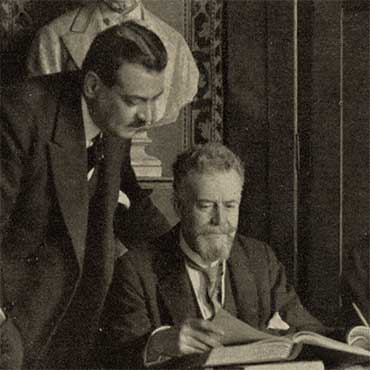Piero Barbèra, the son of Gaspero, was born in Florence, where his father, originally from Turin, had moved and had set up a printing company. He started working in the family firm as a child, while at the same time attending the Istituto svizzero. Before he was twenty years old he was sent to Rome take charge of a branch of the Florence printing press. He ran this branch for a year under the guidance of Ferdinando Serafini, an experienced man that up to that time had been the director of the press in Florence. When his father died in 1880, Piero took over the reins of the firm, together with his brothers, Gino and Luigi. Having worked side by side with the greatest professionals in typesetting and layout (a fact that he celebrated in his Elogio del proto) made Piero Barbèra a real expert in the art of printing, refining his taste, his competence and his technical abilities. Simplicity, proportion in the arrangement of the characters and in the width of the margins, the high quality of the paper and inks used, all these represented his principles of typographical beauty.
His great source of inspiration was the work of Giovan Battista Bodoni, whose bust Barbèra kept in the printing firm’s premises and who was subsequently the subject of one of the “Profili” in the famous series of the publisher Formiggini. These same principles were the inspiration for the printing of the Opere di Galileo Galilei, a monumental work, both because of its size of over 11,000 pages and because of the technical difficulty of dealing with the problems caused by facsimiles, figures, formulas, tables, layout of the critical apparatus, annotations and diagrams. Thanks also to Giovanni Colmignoli, the technical director, who, despite his advanced age, had dealt with the work for twenty years, from the first to the last volume, the result was of the highest quality, both for the accuracy of the printing and for the excellence of the editorial work.
Although the work was not for sale, the national edition of Galileo was possibly the most important undertaking of Piero Barbèra’s period of management, despite being a loss-making venture. Antonio Favaro had been the one that persuaded the Ministry of Education not to entrust the printing of the Galileo edition to the publishers Le Monnier, as had been agreed in the initial stage of the project, raising serious doubts on their financial solidity. The Barbèra publishing house, which in 1902 transferred the printing to the firm Alfani e Venturi, continued to produce the various series started by Gaspero, the founder, and started some new ones in literature and interdisciplinary studies. These were written by the most important authors of the time, who always enjoyed fair and cordial relationships that led to real friendships, as with Giosuè Carducci or Edmondo De Amicis.
Feelings of a common Italian identity and educational aims were the guiding principles of a catalogue of the highest standard, where cultural decisions that were never left to chance. The choice of typography was not the only aspect of the publishing process to which Barbèra paid an almost obsessive attention: he relentlessly pursued the goal of making the contents of the volumes intelligible by means of indexes and auxiliary tools designed to aid research. Piero Barbèra was himself an author, not just of bibliographical works, such as the annals of his own publishing house and other contributions to the history of the book (he was one of the first supports of the decimal classification system devised by Melvil Dewey), but he was also the author of memoirs, biographies, multidisciplinary prefaces to other books and also journalism. He also held a number of posts in the local administration of Florence and in the main cultural institutions of the city. After retiring in 1920, he continued to go every day to the publishing house until he was prevented by a serious illness that led to his death in Florence in 1920.


